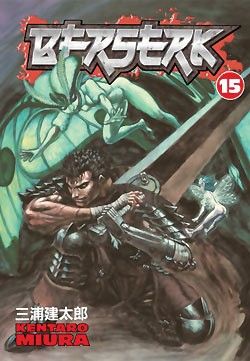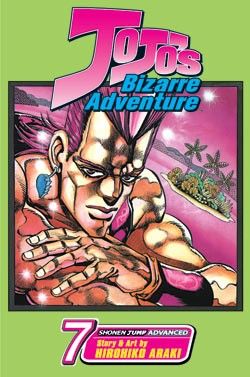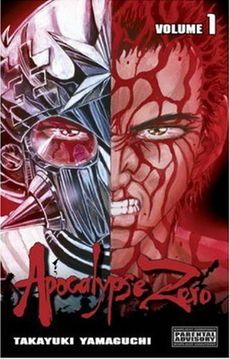One of the best things about reading a lot of manga is being able to trace the lineage of certain types of plots and characters back through the years. Popular series can be massively influential, and I've talked about this before regarding One Piece and some of the modern series it influenced. You can play this game with a lot of series, but one of my absolute favorites is Fist of the North Star. Fist of the North Star itself is an awesome, testosterone-laden series that's very much worth reading, but one of the best things about it is how influential it is. It has plenty of the usual knock-off series and pale imitations, most of which we did not see in English (mostly because Fist of the North Star predates most English translated manga by about 15 years). It inspired series and creators that used the best parts to create their own amazing and, in turn, very influential series.
I try not to cover the same series twice, but I feel like if I'm going to discuss the influence of Fist of the North Star, I might as well bring out the best that topic has to offer. I'll talk about the plots and the finer points of two of these series at a later date, and the third is something I've already discussed, but is worth revisiting in this context.
Fist of the North Star - Written by Buronson, Art by Tetsuo Hara (27 volumes, 9 published in America)
One of the first things I should mention is that Fist of the North Star owes an enormous debt to the film The Road Warrior. Its entire aesthetic is borrowed from the movie, from the post-apocalyptic desert setting, the lone muscled hero that rides into a villain encampment to stir up trouble just because, and even the costumes, such as characters with one shoulderpad, metal-studded leather, and mohawks, are lifted from the movie. But a key difference is that Mad Max is an anti-hero, whereas Kenshiro is a good guy through and through. Fist of the North Star takes the Road Warrior aesthetic and runs with it. For nearly thirty volumes, Kenshiro wanders into a small encampment where a bad guy is physically and financially abusing townsfolk while building himself up to be the greatest fighter the world has ever seen, and Kenshiro effortlessly mops the floor with him. The defeat is always in the form of Kenshiro touching a few points on their body with his finger, stating "You're already dead," and the villain blowing up behind his back. There's nothing more to the series than that, but it's extraordinarily entertaining and absolutely triumphant when Kenshiro takes out one more enormous mohawked tyrant ruining the lives of others. Interestingly, there's no power escalation in this series, since Kenshiro isn't ever seriously challenged by the villains. They get increasingly more evil and ridiculous, such as men big enough to crush children in their fists or ones that have similar fighting techniques, but there's never any doubt that Kenshiro will win. The villains keep getting bigger and more muscular as the series goes on, which is a trait that went on to be imitated in many other places. Kenshiro does not speak, or engage anybody in conversation, so most of the color commentary comes in the form of a traveling companion, a child called Bat in early volumes. It's one of the absolute most classic fighting manga around, and the Hokuto Shinken fighting style went on to be adapted for many a series afterward. The series itself spawned an era in the 80s where comics for boys featured manly, musclebound heroes and villains as opposed to spunky children. Sadly, Fist of the North Star has never been popular in English, despite being translated by two different publishers. There's a handful of loose issues and three volumes from the 90s from Viz, and 9 volumes in a large, colorized edition from defunct publisher Raijin. The Viz volumes are affordable secondhand, although not nearly as cheap as they ought to be, and the Raijin edition is one of the most expensive manga series to obtain secondhand, commanding some of the highest prices you'll see for individual volumes online. Perhaps another publisher will try in the future.
Berserk - Kentaro Miura (36+ volumes)
Berserk is one of the absolute best manga series I've read, and is great to give non-manga readers interested in fantasy comics. Miura does almost everything right here. I'll talk about the fantasy and fantastic elements another time, but I love how the subtle influences of Fist of the North Star show themselves here. That Miura is a fan is more obvious in his one-shot series Japan (written by Buronson, and an awful lot like Fist of the North Star), but you can see some of the influence in Berserk if you know what you're looking for. The main character, Guts, is the same type of stoic, unstoppable force that Kenshiro is, though he gains more personality when we learn his backstory during the first flashback. Guts can be beaten, and is on one memorable occasion, but he usually takes a licking and manages to chop off the head of enormous monsters with his sword allegedly the size of a table. The enormous, musclebound villains that are huge and cruel, but ultimately little or no threat, pop up often early in the series. At one point Guts fights 100 of them, as if this is an insurmountable challenge, and he barely even breaks a sweat to kill them all. While we do learn what drives him through a flashback, as an adult in the present, Guts doesn't often talk about himself or what he's doing, and is accompanied at all times by a fairy named Puck, and later a group of women, children, and hangers-on that offer strangely misplaced bits of humor. Guts's look, with a black cape wandering into a town by himself, is especially like Kenshiro in later volumes of Fist of the North Star. And the ruthless, appallingly evil villains that are built up so it feels good when Kenshiro kills them also appear in Berserk. Guts often wanders into situations where children are being stolen by cannabalistic fairies or trolls are raping the local women in their troll dens. One of the more abstract parallels is the love interests of Kenshiro and Guts. Kenshiro is initially hunting his brother down because he has kidnapped his girlfriend, who is later killed. In theory, Kenshiro's quest is all for the love of a woman. Similarly, Guts is driven by the desire to avenge what happened to Casca, a woman he loved that was driven insane when sacrificed for power by the main villain. Guts's quest is the more heartbreaking one, as Casca later accompanies him in her simple-minded state. But one could argue that both serve as plot devices that make the hero more romantic without actually involving a love interest in an otherwise manly quest. All 36 volumes are in print and available.
Jojo's Bizarre Adventure - Hirohiko Araki (107+ volumes)
There are few things in life that I love as much as Jojo's Bizarre Adventure. While it's easy to recommend Berserk to those with an interest, Jojo's Bizarre Adventure is just so weird that it's difficult to describe in a way that makes people want to read it. It's a lot like a typical battle manga, with a hero that's fighting increasingly powerful bad guys to reach an ultimate villain for a righteous cause. But the best thing about this series is that the fights are almost logic puzzles, where even those with no power can win if they figure out how to outsmart the bad guys or easily defeat their power. In the third and most popular story arc, the main character, Jotaro Kujo, is the most powerful by far, but he doesn't ever fight. They usually defeat enemies by playing video games or breaking mirrors and things like that. While the series is over 100 volumes long, it's broken up into several story arcs, first as a generational series following the Joestar family throughout the 20th century and thereabouts, then with a plot device that allows for alternate historical retellings elsewhere. Araki also has a wicked sense of humor, and has a way of following typical boys comic tropes in a tongue-in-cheek way. I could talk about this series forever, and I have before, but I'll go on at length on another day. The influences of Fist of the North Star include the huge musclebound characters, both heroes and villains, not present in Araki's art until after Fist of the North Star debuts. The incredibly muscular characters are something of a trademark of early volumes of Jojo, but Araki's art is more stylish than Tetsuo Hara would ever want to be, and his unusually dressed musclebound characters are somehow very homoerotic at times. Another parallel is one I already mentioned, that Jotaro Kujo has the most powerful "stand" power of any user, undisputed by every character. He rarely uses it, but when he does, there is really no contest of who will win, even in the final battle. The villains can also be outrageously evil, as they are in Fist of the North Star, but their threats are more veiled and creepy than the overt atrocities of Kenshiro's foes. While a villain in Fist of the North Star may do a lazy demonstration of power by stepping on and killing one of his followers, the main villain in Jojo's Bizarre Adventure may blow up a dog, stop time, then deposit the pieces in the food of patrons of a café. In the earlier parts of Jojo's Bizarre Adventure, the characters also use a special type of martial art that usually ends with their foes exploding messily, as they do in Fist of the North Star. A final, stranger parallel is the sound effects used for punches. Kenshiro often lets loose with an extensive round of "Ah-tah-tah-tah-tah!" when using his pressure points, where Jotaro Kujo's trademark is sometimes a page or three full of nothing but "Ora-ora-ora-ora-ora-ora!" punches. But Jojo's Bizarre Adventure is its own beast, and its current story arc bears little resemblance to the early parts of the series, let alone Fist of the North Star. We were very fortunate to get the third 16-volume story arc translated into English. It is wonderful, and worth every penny, but any out-of-print volume is currently very expensive. Most volumes are still available, however.
Apocalypse Zero - Takayuki Yamaguchi (11 volumes, 6 in English)
I've already talked about this series, but it uses so many of the tropes of Fist of the North Star that I had to bring it up again. The parallels are extensive. The main character practices a highly unrealistic and esoteric martial art that others fear. He's a stoic badass with an incredibly clear and decisive moral compass, and there's never any question that he will ultimately win his fights. The series is set in a post-apocalyptic wasteland whose citizens are terrorized by huge, monstrous atrocities, similar but much more grotesque than those found in Fist of the North Star. We do see them consuming and burning regular citizens alive, which is a lot like the torture scenes in Fist of the North Star that get you pumped to see Kenshiro roll in and kill them. In both series, the younger brother is something of an ultimate bad guy (though as I already mentioned, he's defeated early on in Fist of the North Star), and in both cases, he's jealous of his older brother who inherited the ultimate power. Kakugo even has round scars on his chest like Kenshiro, but he earned his by getting shot with big metal balls, whereas Kenshiro earned his by being touched with the Hokuto no Ken pressure points. But Apocalypse Zero is a thousand times more extreme than Fist of the North Star ever aspired to be. The hero is somehow more pure, the villains more horrible and vile (partially because they are portrayed so grotesquely), the world a much worse place to live. It almost reads like a parody of the genre, but it's so straight-faced that it's impossible to tell whether its intentions are comedic or extreme. That may be the best thing about it. Its nature as a fighting series turned up to 11 will put many off, and while the volumes are out of print, all six translated into English are available cheaply online.





